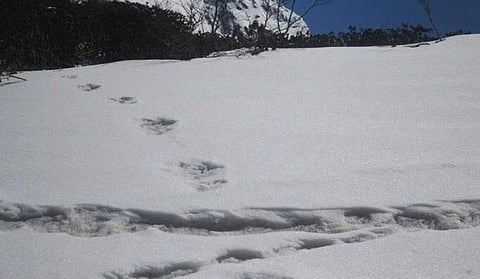

The Indian Army has claimed that an expedition team sighted the "mysterious Footprints of mythical beast 'Yeti'" at the Makalu Base Camp in the Himalayas.
"For the first time, an #IndianArmy Mountaineering Expedition Team has sited mysterious footprints of le beast 'Yeti' measuring 32x15 inches close to Makalu Base Camp on April 9, 2019," the Army's Additional Directorate General of Public Information tweeted late on Monday.
"This elusive snowman has only been sighted at Makalu-Barun National Park in the past," it added.
The Makalu-Barun National Park is located in Nepal's Limbuwan Himalayan region. It is the world's only protected area with an elevation gain of more than 26,000 ft enclosing tropical forest as well as snow-capped peaks.
The Yeti is an ape-like creature, much taller and bigger than an average human. It is covered in thick fur and is believed to inhabit the Himalayas, Siberia, Central, and East Asia. The creature is generally regarded as a legend since there is no solid proof of its existence.
Several theories and experiments throughout the years have suggested that the Yeti, once better known as the Abominable Snowman, is a mysterious bipedal creature said to live in the mountains of Asia. It is sometimes said to leave tracks in the snow but it has also been said to dwell below the Himalayan snow line. Despite dozens of expeditions by people into the remote mountain regions of Russia, China and Nepal, the existence of the Yeti still remains unproven.
Theories have said that the creature is muscular, covered with dark grayish or reddish-brown hair, and weighs between 200 and 400 lbs. (91 to 181 kilograms).
There has been no concrete evidence of its existence yet, but most of it comes from sightings and reports.
In 1960, Sir Edmund Hillary, the first man to scale Mt Everest, had searched for evidence of the Yeti. He was said to have found what seemed to be a scalp from the beast, but scientists later found out that the helmet-shaped hide was in reality made from a serow, a Himalayan animal that has similarities to a goat.
In another instance, in 2007, American TV show host Josh Gates had claimed to have found three mysterious footprints in the snow near a stream in the Himalayas. However, the locals were skeptical about the discovery, suggesting that Gates — who had only been in the area for about a week — simply misinterpreted a bear track. Nothing more had been discovered about what made the footprints.
